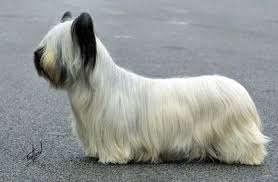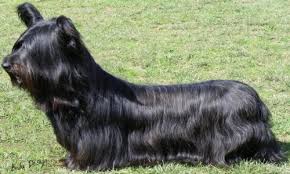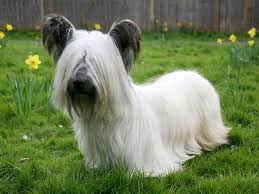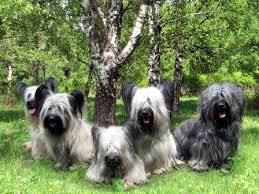(AKC Terrier Group)
 The Skye Terrier is an elegant dog and fiercely loyal to those he knows
and loves. Although a rare breed, anyone who has the opportunity to
share hearth and home with a Skye is truly fortunate. Given the chance,
and with loving instruction, Skyes participate in Obedience, Agility,
Tracking, and Pet Therapy, as well as serving as couch companions.
The Skye Terrier is an elegant dog and fiercely loyal to those he knows
and loves. Although a rare breed, anyone who has the opportunity to
share hearth and home with a Skye is truly fortunate. Given the chance,
and with loving instruction, Skyes participate in Obedience, Agility,
Tracking, and Pet Therapy, as well as serving as couch companions.
General Appearance
The Skye Terrier is a dog of style, elegance and dignity: agile and strong with sturdy bone and hard muscle. Long, low and level-he is twice as long as he is high-he is covered with a profuse coat that falls straight down either side of the body over oval-shaped ribs. The hair well feathered on the head veils forehead and eyes to serve as protection from brush and briar as well as amid serious encounters with other animals. He stands with head high and long tail hanging and moves with a seemingly effortless gait. He is strong in body, quarter and jaw.
 Size, Proportion, Substance
Size, Proportion, Substance
Size--The ideal shoulder height for dogs is 10 inches and bitches 9½ inches. Based on these heights a 10 inch dog measured from chest bone over tail at rump should be 20 inches. A slightly higher or lower dog of either sex is acceptable. Dogs 9 inches or less and bitches 8½ inches or less at the withers are to be penalized. Proportion--The ideal ratio of body length to shoulder height is 2 to 1, which is considered the correct proportion. Substance--Solidly built, full of strength and quality without being coarse. Bone is substantial.
Head
Long and powerful, strength being deemed more important than extreme length. Eyes brown, preferably dark brown, medium in size, close-set and alight with life and intelligence. Ears symmetrical and gracefully feathered. They may be carried prick or drop. If prick, they are medium in size, placed high on the skull, erect at their outer edges, and slightly wider apart at the peak than at the skull. Drop ears, somewhat larger in size and set lower, hang flat against the skull. Moderate width at the back of the skull tapers gradually to a strong muzzle. The stop is slight. The dark muzzle is just moderately full as opposed to snipy. Powerful and absolutely true jaws. The nose is always black. A Dudley, flesh-colored or brown nose shall disqualify. Mouth with the incisor teeth closing level, or with upper teeth slightly overlapping the lower.
Neck, Topline, Body
 Neck--Long and gracefully arched, carried high and proudly. The backline is level. Body pre-eminently long and low, the chest deep, with oval-shaped
ribs. The sides appear flattish due to the straight falling and profuse
coat. Tail long and well feathered. When hanging, its upper section
is pendulous, following the line of the rump, its lower section thrown back
in a moderate arc without twist or curl. When raised, its height makes it
appear a prolongation of the backline. Though not to be preferred, the tail
is sometimes carried high when the dog is excited or angry. When such carriage
arises from emotion only, it is permissible. But the tail should not be
constantly carried above the level of the back or hang limp.
Neck--Long and gracefully arched, carried high and proudly. The backline is level. Body pre-eminently long and low, the chest deep, with oval-shaped
ribs. The sides appear flattish due to the straight falling and profuse
coat. Tail long and well feathered. When hanging, its upper section
is pendulous, following the line of the rump, its lower section thrown back
in a moderate arc without twist or curl. When raised, its height makes it
appear a prolongation of the backline. Though not to be preferred, the tail
is sometimes carried high when the dog is excited or angry. When such carriage
arises from emotion only, it is permissible. But the tail should not be
constantly carried above the level of the back or hang limp.
Forequarters
Shoulders well laid back, with tight placement of shoulder blades at the withers and elbows should fit closely to the sides and be neither loose nor tied. Forearm should curve slightly around the chest. Legs short, muscular and straight as possible. "Straight as possible" means straight as soundness and chest will permit, it does not mean "Terrier straight." Feet-- Large hare-feet preferably pointing forward, the pads thick and nails strong and preferably black.
Hindquarters
Strong, full, well developed and well angulated. Legs short, muscular and straight when viewed from behind. Feet as in front.
 Coat
Coat
Double. Undercoat short, close, soft and woolly. Outer coat hard, straight and flat. 5½ inches long without extra credit granted for greater length. The body coat hangs straight down each side, parting from head to tail. The head hair, which may be shorter, veils forehead and eyes and forms a moderate beard and apron. The long feathering on the ears falls straight down from the tips and outer edges, surrounding the ears like a fringe and outlining their shape. The ends of the hair should mingle with the coat of the neck. Tail well feathered.
Color
The coat must be of one over-all color at the skin but may be of varying shades of the same color in the full coat, which may be black, blue, dark or light grey, silver platinum, fawn or cream. The dog must have no distinctive markings except for the desirable black points of ears, muzzle and tip of tail, all of which points are preferably dark even to black. The shade of head and legs should approximate that of the body. There must be no trace of pattern, design or clear-cut color variations, with the exception of the breed's only permissible white which occasionally exists on the chest not exceeding 2 inches in diameter.
 The puppy coat may be very different in color from the adult coat. Therefore,
as it is growing and clearing, wide variations of color may occur; consequently,
this is permissible in dogs under 18 months of age. However, even in puppies
there must be no trace of pattern, design, or clear-cut variations with the
exception of the black band encircling the body coat of the creme colored dog,
and the only permissible white which, as in the adult dog, occasionally exists
on the chest not exceeding 2 inches in diameter.
The puppy coat may be very different in color from the adult coat. Therefore,
as it is growing and clearing, wide variations of color may occur; consequently,
this is permissible in dogs under 18 months of age. However, even in puppies
there must be no trace of pattern, design, or clear-cut variations with the
exception of the black band encircling the body coat of the creme colored dog,
and the only permissible white which, as in the adult dog, occasionally exists
on the chest not exceeding 2 inches in diameter.
Gait
The legs proceed straight forward when traveling. When approaching, the forelegs form a continuation of the straight line of the front. The feet being the same distance apart as the elbows. The principal propelling power is furnished by the back legs which travel straight forward. Forelegs should move well forward, without too much lift. The whole movement may be termed free, active and effortless and give a more or less fluid picture.
Disqualification
A Dudley, flesh-colored or brown nose shall disqualify.
Approved February 10, 1990
Effective March 28, 1990
Being an achondroplastic dog breed with extremely short legs, the Skye Terrier has particular health concerns. The most preventable is often called Skye limp or Puppy limp, and it is due to premature closure of the distal radial growth plate. If a Skye is exercised too often, too young, especially before 8 months, they can damage their bone growth, leading to a painful limp and possibly badly bowed legs. Jumping up and down from objects, climbing over objects, running, even long walks, are all things to be avoided for the first 8 to 10 months to prevent later problems and allow for correct closure of the growth plate.
Degenerative disc disease is also a common problem in short-legged dogs, and as many as 10% of Skyes will suffer from it.
Mammary cancer is the leading cause of Skye Terrier deaths, with Hemangiosarcomas (a malignant tumour of the blood vessels), Autoimmune disease, and Hyperthyroidism[1] as other concerns of the breed.
Overall, the breed is still considered quite healthy, and the average lifespan is 12–15 years.

 That of the typical working terrier capable of overtaking
game and going to ground, displaying stamina, courage, strength and agility.
Fearless, good-tempered, loyal and canny, he is friendly and gay with those
he knows and reserved and cautious with strangers.
That of the typical working terrier capable of overtaking
game and going to ground, displaying stamina, courage, strength and agility.
Fearless, good-tempered, loyal and canny, he is friendly and gay with those
he knows and reserved and cautious with strangers.
The majority of terriers have attained something of their present-day form within the last century, but the Skye Terrier of nearly four centuries ago was like the specimens of today.
 Thus we find the Skye Terrier of today. His flowing coat is the same
as the one that proved such a grand protection in the days when his only
occupation was to challenge vicious animals that otherwise might have
crippled him at a single bite. Perhaps this long coat has been a
handicap, for all followers of this game old working terrier have
witnessed him surpassed in popularity by one after another of the newer
breeds. Still they are reluctant to change him in any manner.
Thus we find the Skye Terrier of today. His flowing coat is the same
as the one that proved such a grand protection in the days when his only
occupation was to challenge vicious animals that otherwise might have
crippled him at a single bite. Perhaps this long coat has been a
handicap, for all followers of this game old working terrier have
witnessed him surpassed in popularity by one after another of the newer
breeds. Still they are reluctant to change him in any manner.
The breed takes its name from the chief of those northwestern islands of Scotland that, as far back as he can be traced, formed his native home, and in which he was found in greatest perfection. He is the only terrier distinctively belonging to the northwestern islands that is not common to the whole of Scotland. Those who have the best practical knowledge of the Skye maintain that he is without rival in his own peculiar domain, and that wherever there are rocks, dens, burrow, cairns, or coverts to explore, or waters to take to, his services should be called.
 The Skye was the most widely known of all the terriers down to the
end of the 19th century. Queen Victoria's early interest and Sir Edwin
Landseer's paintings featuring the breed helped attract attention. He
was kept in all the English-speaking countries. Since then he has
slipped quietly into the background, yet his admirers in England and
Scotland - where he has maintained his greatest foothold - are happy to
point to the time when "a duchess would almost be ashamed to be seen in
the park unaccompanied by her long-coated Skye."
The Skye was the most widely known of all the terriers down to the
end of the 19th century. Queen Victoria's early interest and Sir Edwin
Landseer's paintings featuring the breed helped attract attention. He
was kept in all the English-speaking countries. Since then he has
slipped quietly into the background, yet his admirers in England and
Scotland - where he has maintained his greatest foothold - are happy to
point to the time when "a duchess would almost be ashamed to be seen in
the park unaccompanied by her long-coated Skye."
The Skye Terrier was first registered with the AKC in 1887 and was one of the most important breeds at American bench shows before the turn of the century. The rivalry among the leading kennels was exceptionally keen. Although the frontiers of his activities have been somewhat curtailed, the true value of the Skye Terrier is evinced by the tenacious grasp which he has on those who have come in contact with him. Thus, entries may sometimes be small at bench shows today, but seldom does one find a major show without some specimens of this old terrier breed.


Skye Terrier AKC Breed Standards
General Appearance
The Skye Terrier is a dog of style, elegance and dignity: agile and strong with sturdy bone and hard muscle. Long, low and level-he is twice as long as he is high-he is covered with a profuse coat that falls straight down either side of the body over oval-shaped ribs. The hair well feathered on the head veils forehead and eyes to serve as protection from brush and briar as well as amid serious encounters with other animals. He stands with head high and long tail hanging and moves with a seemingly effortless gait. He is strong in body, quarter and jaw.
Size--The ideal shoulder height for dogs is 10 inches and bitches 9½ inches. Based on these heights a 10 inch dog measured from chest bone over tail at rump should be 20 inches. A slightly higher or lower dog of either sex is acceptable. Dogs 9 inches or less and bitches 8½ inches or less at the withers are to be penalized. Proportion--The ideal ratio of body length to shoulder height is 2 to 1, which is considered the correct proportion. Substance--Solidly built, full of strength and quality without being coarse. Bone is substantial.
Head
Long and powerful, strength being deemed more important than extreme length. Eyes brown, preferably dark brown, medium in size, close-set and alight with life and intelligence. Ears symmetrical and gracefully feathered. They may be carried prick or drop. If prick, they are medium in size, placed high on the skull, erect at their outer edges, and slightly wider apart at the peak than at the skull. Drop ears, somewhat larger in size and set lower, hang flat against the skull. Moderate width at the back of the skull tapers gradually to a strong muzzle. The stop is slight. The dark muzzle is just moderately full as opposed to snipy. Powerful and absolutely true jaws. The nose is always black. A Dudley, flesh-colored or brown nose shall disqualify. Mouth with the incisor teeth closing level, or with upper teeth slightly overlapping the lower.
Neck, Topline, Body
 Neck--Long and gracefully arched, carried high and proudly. The backline is level. Body pre-eminently long and low, the chest deep, with oval-shaped
ribs. The sides appear flattish due to the straight falling and profuse
coat. Tail long and well feathered. When hanging, its upper section
is pendulous, following the line of the rump, its lower section thrown back
in a moderate arc without twist or curl. When raised, its height makes it
appear a prolongation of the backline. Though not to be preferred, the tail
is sometimes carried high when the dog is excited or angry. When such carriage
arises from emotion only, it is permissible. But the tail should not be
constantly carried above the level of the back or hang limp.
Neck--Long and gracefully arched, carried high and proudly. The backline is level. Body pre-eminently long and low, the chest deep, with oval-shaped
ribs. The sides appear flattish due to the straight falling and profuse
coat. Tail long and well feathered. When hanging, its upper section
is pendulous, following the line of the rump, its lower section thrown back
in a moderate arc without twist or curl. When raised, its height makes it
appear a prolongation of the backline. Though not to be preferred, the tail
is sometimes carried high when the dog is excited or angry. When such carriage
arises from emotion only, it is permissible. But the tail should not be
constantly carried above the level of the back or hang limp.Forequarters
Shoulders well laid back, with tight placement of shoulder blades at the withers and elbows should fit closely to the sides and be neither loose nor tied. Forearm should curve slightly around the chest. Legs short, muscular and straight as possible. "Straight as possible" means straight as soundness and chest will permit, it does not mean "Terrier straight." Feet-- Large hare-feet preferably pointing forward, the pads thick and nails strong and preferably black.
Hindquarters
Strong, full, well developed and well angulated. Legs short, muscular and straight when viewed from behind. Feet as in front.
Double. Undercoat short, close, soft and woolly. Outer coat hard, straight and flat. 5½ inches long without extra credit granted for greater length. The body coat hangs straight down each side, parting from head to tail. The head hair, which may be shorter, veils forehead and eyes and forms a moderate beard and apron. The long feathering on the ears falls straight down from the tips and outer edges, surrounding the ears like a fringe and outlining their shape. The ends of the hair should mingle with the coat of the neck. Tail well feathered.
Color
The coat must be of one over-all color at the skin but may be of varying shades of the same color in the full coat, which may be black, blue, dark or light grey, silver platinum, fawn or cream. The dog must have no distinctive markings except for the desirable black points of ears, muzzle and tip of tail, all of which points are preferably dark even to black. The shade of head and legs should approximate that of the body. There must be no trace of pattern, design or clear-cut color variations, with the exception of the breed's only permissible white which occasionally exists on the chest not exceeding 2 inches in diameter.
Gait
The legs proceed straight forward when traveling. When approaching, the forelegs form a continuation of the straight line of the front. The feet being the same distance apart as the elbows. The principal propelling power is furnished by the back legs which travel straight forward. Forelegs should move well forward, without too much lift. The whole movement may be termed free, active and effortless and give a more or less fluid picture.
Disqualification
A Dudley, flesh-colored or brown nose shall disqualify.
Approved February 10, 1990
Effective March 28, 1990
Skye Terrier Health Issues
Being an achondroplastic dog breed with extremely short legs, the Skye Terrier has particular health concerns. The most preventable is often called Skye limp or Puppy limp, and it is due to premature closure of the distal radial growth plate. If a Skye is exercised too often, too young, especially before 8 months, they can damage their bone growth, leading to a painful limp and possibly badly bowed legs. Jumping up and down from objects, climbing over objects, running, even long walks, are all things to be avoided for the first 8 to 10 months to prevent later problems and allow for correct closure of the growth plate.
Degenerative disc disease is also a common problem in short-legged dogs, and as many as 10% of Skyes will suffer from it.
Mammary cancer is the leading cause of Skye Terrier deaths, with Hemangiosarcomas (a malignant tumour of the blood vessels), Autoimmune disease, and Hyperthyroidism[1] as other concerns of the breed.
Overall, the breed is still considered quite healthy, and the average lifespan is 12–15 years.
Skye Terrier Temperament
Did You Know?
- The Skye Terrier was a fashionable pet of all degrees after being accepted in court, by the Kings and Queens of England.
- The Skye was first registered with the AKC in 1887.
- Skyes were bred by farmers as working terriers whose function was to destroy fox, badger and otter.
- Originally, the drop eared variety was favored for this work, but later, in the nineteenth century, the prick eared variety became more popular as a pet and show dog, partly as a result of Queen Victoria's fondness for the breed.
- The famous Skye Terrier, Greyfriars Bobby was so devoted to his master John Gray, even in death, for fourteen years Bobby lay on the grave only leaving for food.
- The Skye was much favored as a house pet of the Scottish lairds and eventually gained considerable status with the English aristocracy. There was a time when any self respecting duchess would have been ashamed to be seen in the park without her fashionable Skye Terrier.
Skye Terrier History
The majority of terriers have attained something of their present-day form within the last century, but the Skye Terrier of nearly four centuries ago was like the specimens of today.
The breed takes its name from the chief of those northwestern islands of Scotland that, as far back as he can be traced, formed his native home, and in which he was found in greatest perfection. He is the only terrier distinctively belonging to the northwestern islands that is not common to the whole of Scotland. Those who have the best practical knowledge of the Skye maintain that he is without rival in his own peculiar domain, and that wherever there are rocks, dens, burrow, cairns, or coverts to explore, or waters to take to, his services should be called.
The Skye Terrier was first registered with the AKC in 1887 and was one of the most important breeds at American bench shows before the turn of the century. The rivalry among the leading kennels was exceptionally keen. Although the frontiers of his activities have been somewhat curtailed, the true value of the Skye Terrier is evinced by the tenacious grasp which he has on those who have come in contact with him. Thus, entries may sometimes be small at bench shows today, but seldom does one find a major show without some specimens of this old terrier breed.
Skye Terrier Pics
AKC Registered Breeders
Skye Terrier
Parent Club: Skye Terrier Club of America
Breeder Referral: Joan Fingar; EST (585) 247-3086 Sloughi
Parent Club: American Sloughi Association, Inc.
Parent Club: Skye Terrier Club of America
Breeder Referral: Joan Fingar; EST (585) 247-3086 Sloughi
Parent Club: American Sloughi Association, Inc.
No comments:
Post a Comment